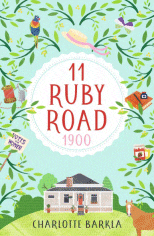
11 Ruby Road: 1900
11 Ruby Road: 1900
Charlotte Barkla
Walker Books, 2024
192pp., pbk., RRP $A16.99
9781760657949
Ever since her Great Aunt Mildred picked the vacant block on the new housing development as a child in 1863 because she loved its giant Moreton Bay fig tree, it has belonged to Dorothy’s family and now they have moved from the country to the city to live in the house and run the store that Mildred’s mother established.
But city life is very different to the rural one Dorothy has known. Ruby Road is bustling – full of families and children, horse-drawn carts and even a mysterious dog – and there are many other changes such as having to go to school and crossing swords with Miss Armstrong who insists on perfect printing of letters and needlework , despite Dorothy’s love of writing stories which she does in her secret writing room. Meeting a young Asian boy who also likes to write stories, Dorothy not only finds an outlet and audience for her imagination, but is also exposed to prejudice and racism, particularly towards the Chinese who were blamed for “taking all the gold” from the gold rush and inspired the White Australia Policy, as the colonies united to become one country. Inspired by a declaration by her Aunt Esme that she wouldn’t marry and be the possession of a man, Dorothy dreams of being a famous actress and independent and writes a play that she persuades the neighbourhood children to perform. But then a conversation between her mother and Esme about women having the right to vote and have a say in their lives, inspires a change of focus… and hopefully, a change in thinking for many.
Somewhat akin to the concept of Nadia Wheatley’s classic, My Place, this is the first in a series tracing the stories of the occupants of 11 Ruby Road in Brisbane, introducing young independent readers to the lives of those who lived in the times, as well as the genre of historical fiction. It opens up many avenues of Australia’s history to explore – federation, racism, the status of women- all of which give today’s children an insight into how things were and an opportunity to investigate how and why they have changed.
A series worth following and offering to those investigating or interested in this country’s history in a way that makes it meaningful and accessible.